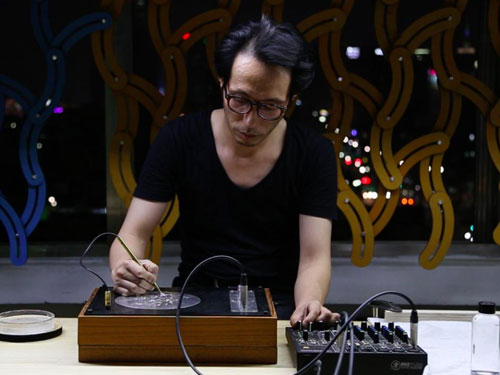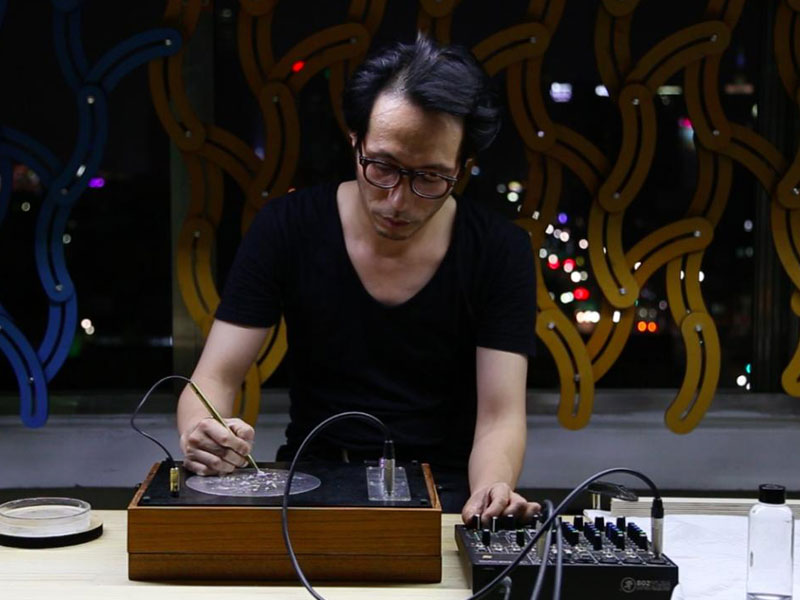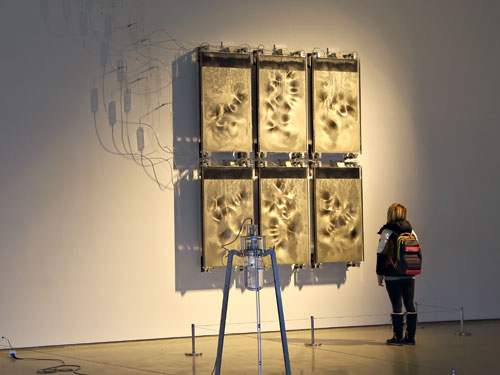Arts & Culture: Artist in Physicist’s Clothing
Yunchul Kim has many of the trappings of a scientist. He has a lab where he tinkers with home-made detectors and microfluidic devices. He mixes exotic chemicals in glass beakers and tests their responses to temperature changes and magnetic fields. And he keeps track of his data in notebooks with diagrams of future project ideas. But for all that, Kim is not a scientist. He is an artist who uses scientific methods to create dynamic art pieces with photonic crystals and other strangely beautiful materials (Fig. 1). Utilizing magnets, turbulent flows, and even cosmic rays, he makes pieces that swirl, bubble, and pop.
In recognition of his exquisite blending of art and science, Kim was awarded the 5th COLLIDE International Award offered by CERN in Geneva. This annual prize—which attracted over 900 applicants last year—gives winning artists the opportunity to spend two months at CERN, where they can interact with scientists and develop ideas for future art pieces. Kim arrived at CERN in February 2017. He spoke about his artwork and his brief experience at CERN one sunny afternoon in the bustling CERN cafeteria. The artist seemed at ease surrounded by particle physicists, cosmologists, and string theorists. “[Scientists] need a lot of imagination to discover the world,” said Kim. “Without imagination, science can’t progress, and it is the same with art.”
Kim has exhibited pieces at museums and galleries in his native South Korea, as well as in Europe, where he studied for several years. His artwork contains elements that a physicist would be familiar with. For example, an installation called Effulge centers on six constantly evolving panels filled with a photonic crystal (Fig. 2). This reflective material is made up of nanosized iron grains in a liquid suspension, which is continuously stirred by air pumps triggered by a cosmic-ray muon detector. But you don’t have to understand all the mechanical workings to enjoy the piece. “My work is very complex to produce, but it is very easy to view,” Kim said. His goal is not education. The art is accompanied by very few technical details, so as not to distract the viewer from the direct experience. Citing the French philosopher Gaston Bachelard, Kim remarked that you don’t need to know the physics of fire to be mesmerized by the flicker of a candle flame.
Of course, viewers can ask questions if they are curious. In this case, the artwork becomes an entry point for exploring the underlying science and technology. Kim himself has no formal scientific training, but he has taught himself many tools of the trade. He built the muon detector for Effulge from scratch by connecting a pair of Geiger-counter tubes. He also devised and fabricated the photonic crystal in a step-by-step fashion that could have come straight out of a research handbook. The process began several years ago when Kim had the idea of creating a fluid of metallic grains that would reflect light in a constantly changing way. As a first try, he ground iron powder, but he soon realized the grains needed to be smaller. By researching the literature, he came across a chemical reaction that produces nanometer-sized grains from a mixture of iron chloride and ammonia.
After some more trial and error, he finally came up with a material that matched his original vision. He was later told that his creation was a photonic crystal. The grains scatter light in different ways depending not only on their motion but also on any applied magnetic field. This magnetic response attracted the attention of astrophysicist Jaime Forero-Romero now at the University of Andes in Colombia, who saw an analogy to dark matter in the behavior of Kim’s grains. Forero-Romero, Kim, and art and astronomy historian Lucía Ayala teamed up to organize a small symposium on dark matter and fluid instabilities called Fluid Cosmologies in 2012. Kim recounted this exchange to dispel a common misconception about “art and science collaborations” as being only a chance for artists to learn from scientists. In reality, knowledge and experience are shared in both directions, he said. CERN physicist Helga Timko worked closely with Kim during his art residency, and she confirmed that Kim was not the only one benefiting from his time there. “I am also taking home inspiration,” Timko said.
During his CERN residency, Kim did not work on any specific project. Instead, he used the time to meet with scientists and tour their facilities. He learned about the latest detector technologies, as well as the future of particle physics after the discovery of the Higgs boson. But this information isn’t as valuable to him as the human interactions he had. Just being with scientists and seeing how they work provides a fuller understanding than a Wikipedia page, he said. Kim is currently attending a second residency—also part of the COLLIDE award—at FACT (Foundation for Art and Creative Technology) in Liverpool, England. This one-month-long program involves artist workshops and studio time. Kim will then head back to Korea, where he’ll put on his “lab coat” and continue his work on a project called Cascade, in which he aims to find new ways to control the propagation of light in materials.
–Michael Schirber
Michael Schirber is a Corresponding Editor for Physics based in Lyon, France.







